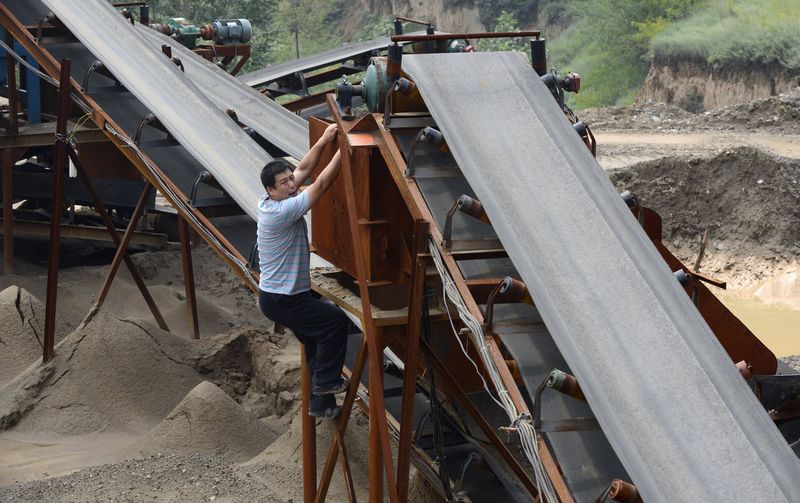By Manolo Serapio Jr and Ruby Lian
SINGAPORE/SHANGHAI (Reuters) - The world's big three iron ore miners appear to be entering the final phase of a fight to increase market share in China as massive expansions drive more high-cost rivals out of business.
The global giants have met stubborn resistance after many big Chinese miners kept producing despite weaker iron ore prices, helping push prices far lower than Rio Tinto (AX:RIO) (L:RIO), BHP Billiton (AX:BHP) (L:BLT) and Vale (SA:VALE5) envisaged when they began to flood the world with ore two years ago.
However, cracks are starting to appear in even China's resilient state-mining sector, where mines can have production costs 20-50 percent above the market but also employ thousands of workers and are aligned with big steel makers.
One mine in Beijing that produces about 2 million tonnes of iron ore concentrate a year plans to suspend production for one-and-a-half months from this month, the first state-owned mine to do so, industry sources said.
Further price falls would bring more mine closures, said analyst Zhao Chaoyue, with China Merchant Futures in Guangzhou.
"That includes some state-owned mines owned by steel mills, which are likely to give up their own iron ore output and turn to cheap imported ore too," Zhao said.
Large, state-owned steel producers such as Angang Group (SZ:000898), Shougang Corp (SZ:000959) and Hebei Iron and Steel (SZ:000709) own a big chunk of the country's iron ore mines.
Angang declined to comment but its iron ore arm said on its website last month that its growth would "play a role in fighting against foreign monopolies" as well as "safeguarding national economic security". Officials at Shougang and Hebei Steel could not be reached for comment.
The lower prices are also forcing smaller miners in Australia, Canada and elsewhere to shutter production, helping the big miners to tighten their grip on the Chinese market, which accounts for two thirds of global demand.
Ore shipments to China rose 14 percent last year even as its steel output was nearly flat. China's own raw ore production fell in the final quarter of 2014, and industry executives estimate a third of the country's mines have halted production.
"It's all about returns. If (the big miners) can do it, why wouldn't they? There are very few commodities for all these companies where they can grow and generate a meaningful return," said Ric Ronge, a portfolio manager at Pengana Capital.
The "survival of the fittest" strategy, outlined by Rio Chief Executive Sam Walsh, is expected to see imports from Australia and Brazil take more than 80 percent of the Chinese market in 2015, from 64 percent four years earlier.
MARGINS CUT
Globally, around 170 million tonnes of iron ore, or 12 percent of last year's global trade, has been removed from the market over the past 12 months, according to Morgan Stanley.
The big three miners, together with Australia's Fortescue Metals Group (AX:FMG), added 234 million tonnes of iron ore to global seaborne supply in the past two years, and will add another 196 million tonnes by 2020, according to Vale.
Iron ore has tumbled to less than a third of the price it commanded at the peak of the boom, but the majors have been able to cut costs. Margins, a gauge of profitability, have been squeezed but remain well above the industry average.
From above 60 percent in early 2011, when iron ore reached nearly $200 a tonne, top iron ore miner Vale's operating margin fell to 17.8 percent in the September quarter last year, data from Thomson Reuters Starmine showed.
It was the first time Vale's margin dropped below 20 percent since late 2009 although it was still well above the industry average of 9.4 percent, based on the data.
China's domestic supply is likely to fall by another 70 million tonnes this year, or about a fifth of the country's output in terms of equivalent imported ore grade, according to the China Iron and Steel Association.
Outside of China, Goldman Sachs estimates another 50 million tonnes of marginal supply may be at risk this year, despite some assistance from a stronger U.S. dollar, lower freight costs and lower oil.
While the plunge in prices will take a toll on the big miners' earnings due in coming weeks, it may help cement their grip on China's market.
Iron ore fell to $61.10 (£40.10) a tonne <.IO62-CNI=SI> last week, its lowest since May 2009, and a price between $60 and $70 a tonne could suit big miners, said Carsten Menke, commodity analyst at Julius Baer.
"The optimal strategy for them would be to target a price range where they remain profitable, as well as cash-flow positive, and where no supply expansion from other high-cost producers is incentivised," he said.
